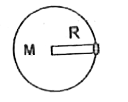Consider a spherical planet of radius R . Its density varies with the distance of its centre t as ρ=A−Br, where A and B are positive constants. Now answer the following questions.
Acceleration due to gravity at a distance r(r<R) from its centre is
43πGr(A−Br)
(4)πGr(A−Br)
43πGr(A−34Br)
43πGr(A−32Br)
The correct Answer is:C
To find the acceleration due to gravity at a distance r from the center of a spherical planet with a variable density given by ρ=A−Br, we will follow these steps:
Step 1: Define the density function
The density of the planet varies with the distance from its center and is given by:
ρ(r)=A−Br
where A and B are positive constants.
Step 2: Calculate the mass enclosed within radius r
To find the mass M enclosed within a radius r, we need to integrate the density over the volume of the sphere of radius r. The volume element in spherical coordinates is given by:
dV=4πr′2dr′
Thus, the mass M can be calculated as:
M=∫r0ρ(r′)dV=∫r0(A−Br′)(4πr′2)dr′
Step 3: Evaluate the integral
Now we evaluate the integral:
M=4π∫r0(A−Br′)r′2dr′
This can be split into two parts:
M=4π(A∫r0r′2dr′−B∫r0r′3dr′)
Calculating the integrals:
1. ∫r0r′2dr′=r33
2. ∫r0r′3dr′=r44
Substituting these results back:
M=4π(A⋅r33−B⋅r44)
M=4π3Ar3−πBr4
Step 4: Use the formula for acceleration due to gravity
The acceleration due to gravity g at a distance r from the center is given by:
g=GMr2
Substituting for M:
g=G(4π3Ar3−πBr4)r2
Simplifying this, we get:
g=4πG3Ar−πGBr2
Final Expression
Thus, the acceleration due to gravity at a distance r from the center of the planet is:
g=4πG3Ar−πGBr2
The density of the planet varies with the distance from its center and is given by:
ρ(r)=A−Br
where A and B are positive constants.
To find the mass M enclosed within a radius r, we need to integrate the density over the volume of the sphere of radius r. The volume element in spherical coordinates is given by:
dV=4πr′2dr′
Thus, the mass M can be calculated as:
M=∫r0ρ(r′)dV=∫r0(A−Br′)(4πr′2)dr′
Now we evaluate the integral:
M=4π∫r0(A−Br′)r′2dr′
This can be split into two parts:
M=4π(A∫r0r′2dr′−B∫r0r′3dr′)
Calculating the integrals:
1. ∫r0r′2dr′=r33
2. ∫r0r′3dr′=r44
M=4π(A⋅r33−B⋅r44)
M=4π3Ar3−πBr4
The acceleration due to gravity g at a distance r from the center is given by:
g=GMr2
Substituting for M:
g=G(4π3Ar3−πBr4)r2
Simplifying this, we get:
g=4πG3Ar−πGBr2
Thus, the acceleration due to gravity at a distance r from the center of the planet is:
g=4πG3Ar−πGBr2
Topper's Solved these Questions
Similar Questions
A satellite of mass m is moving in a circular or orbit of radius R around the earth. The radius of the earth is r and the acceleration due to gravity at the surface of the earth is g. Obtain expressions for the following :
(a) The acceleration due to gravity at a distance R from the centre of the earth
(b) The linear speed of the satellite
(c ) The time period of the satellite
View SolutionIf earth is assumed to be a sphere of uniform density then plot a graph between acceleration due to gravity (g) and distance from the centre of earth.
View SolutionIn a spherical region the densiy varies inversely with the distance from ther centre Gravitational field at a distance r from the centre is .
View SolutionIn a hypothetical uniform and spherical planet of mass M and radius R, a tunel is dug radiay from its surface to its centre as shown. The minimum energy required to carry a unit mass from its centre to the surface is kmgR. Find value of k. Acceleration due to gravity at the surface of the planet is g.

View SolutionThe surface mass density of a disc of radius a varies with radial distance as σ=A+Br where A & B are positive constants then moment of inertia of the disc about an axis passing through its centre and perpendicular to the plane
View SolutionA hollow metal sphere of radius 5 cm is charged such that the potential on its surface is 10 V. The potential at the centre of the sphere is
View SolutionA conducting sphere of radius R2 has a spherical cavity of radius R1 which is non concentric with the sphere. A point charge q1 is placed at a distance r from the centre of the cavity. For this arrangement, answer the following questions.
Electric potential at the centre of the cavity will be :
View SolutionThe mass density of a planet of radius R varie with the distance r form its centre as ρ(r)=p0(1−r2R2). Then the graviational field is maximum at :
View SolutionStarting from the centre of the earth having radius R, the variation of g (acceleration due to gravity) is shown by
View SolutionA solid sphere of mass M and radius R has a spherical cavity of radius R/2 such that the centre of cavity is at a distance R/2 from the centre of the sphere. A point mass m is placed inside the cavity at a distance R/4 from the centre of sphere. The gravitational force on mass m is
View Solution
